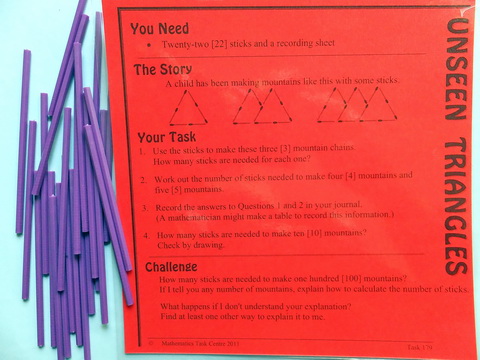
Unseen TrianglesTask 179 ... Years 4 - 8SummaryThis is another of several tasks which begin with an easily accessed concrete/visual pattern, but lead on to considerable algebraic possibilities. Students are asked to make a range of 'mountain peaks' which look like each mountain partially obscures the one behind. The main challenge in the problem is:
Unseen Triangles also appears on the Picture Puzzles Pattern & Algebra B menu where the problem is presented using one screen, two learners, concrete materials and a challenge. |
Materials
Content
|

IcebergA task is the tip of a learning iceberg. There is always more to a task than is recorded on the card. |
Answers are:
and students should keep this record in their journal. The iceberg begins with the last challenge: Find at least one other way to explain it to me. Why? Because when a mathematician is working on a problem there is no one else who they can ask about whether they are correct. Therefore they must ask:
Extend further with questions such as:
 Are these girls on the way to developing a pattern of diamonds (rhombii)? All tasks have three lives. The task life (above) is an invitation to work like a mathematician. To this can be added an Investigation Guide which leads students deeper into the iceberg of a task. Staff construct the Guide in advance based on the extension questions. This is the second life. The third life is as a whole class investigation to model the work of a mathematician. This third life is described below. Generally, the use of an Investigation Guide follows the completion of the card and a discussion with the teacher which helps to reveal something of the extension questions. Then the teacher asks:
Guides like this are included for the 20 tasks in the Maths With Attitude Pattern & Algebra Years 7 & 8 kit and for 10 tasks in the Maths With Attitude Pattern & Algebra Years 9 & 10 kit. Investigation Guides can lead to students publishing a report of their investigation. See Recording & Publishing for examples of student reports in various forms and see Assessment for a rubric for assessing such reports that has been submitted by Jodi Wilson and Maria Antoniou, Mt. Eliza Secondary College, and another from Damian Howison and the staff from Mackillop College, Swan Hill. |
Whole Class InvestigationTasks are an invitation for two students to work like a mathematician. Tasks can also be modified to become whole class investigations which model how a mathematician works. |
To convert this task to a whole class lesson with the purpose of addressing all the mathematics above while modelling what it means to work like a mathematician, you need plenty of pop sticks or an alternative such as straws cut to size. However, for a greater level of involvement, which is sensible management because it adds purpose to using the sticks before they are distributed, begin with each student quickly preparing a newspaper roll. Students bring this to a central floor space and a whole class model of the mountain peaks is quickly constructed. You can see photos of this approach in the Match Triangles cameo. Discussion and challenge begins with the floorboard model and the table top models are then used to explore and confirm hypotheses before returning to the public model for discussion and extension. Many teachers report that an added advantage of lessons like these is that when the next lesson is a related 'toolbox lesson', perhaps from a text book, students often comment that the ...stuff in the book is simple. For more ideas and discussion about this investigation, open a new browser tab (or page) and visit Maths300 Lesson 20, Unseen Triangles. |
Is it in Maths With Attitude?Maths With Attitude is a set of hands-on learning kits available from Years 3-10 which structure the use of tasks and whole class investigations into a week by week planner. |
The Unseen Triangles task is an integral part of:
The Unseen Triangles lesson is an integral part of:
Unseen Triangles task is also included in the Task Centre Kit for Aboriginal Students. |